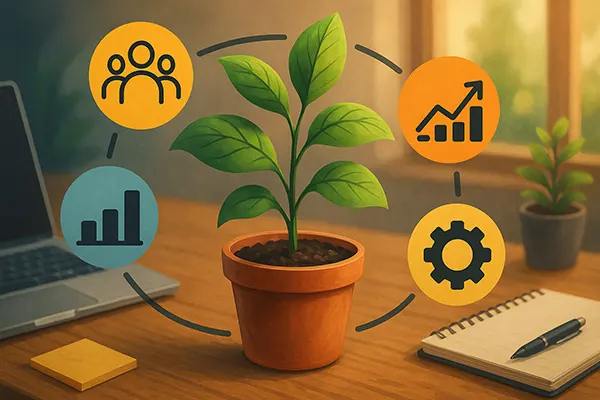
From Freelancing to Product Startup: A Step-by-Step Model with Real Examples (2025)
In 2025, thousands of freelancers are facing the same challenge: stable income from clients, but no path to scale. You can’t serve more clients without sacrificing time or quality. Transitioning to a product startup is the next logical move — one that leverages your service experience, existing client insights, and no-code tools to build something scalable and valuable. This article outlines a clear, practical model for making that transition, backed by real tools and current examples.
Why Freelancing Limits Your Growth Potential
Freelancing offers autonomy, flexibility, and direct income. But it comes with a built-in ceiling: your revenue is tied to your time. You can’t scale yourself. Even hiring subcontractors or raising your rates only shifts the bottleneck. For most freelancers, each new project still requires their direct involvement, and eventually, time becomes the limiting factor.
This ceiling often feels invisible until you hit it. You may be fully booked, generating decent income, and even outsourcing some tasks — yet you still feel stuck. The work doesn’t grow without more effort, and there’s little leverage in the model. That’s where the shift to a product mindset becomes critical.
With a product, you create something once and sell it multiple times. Your time decouples from your revenue. This is the core difference between service work and a startup. But you don’t need to leave everything behind to make the leap — you can transition step by step.
Identifying the Repetitive Core of Your Service
Every freelancer has a “repeated layer” — something you do in every project. Designers repeat visual briefs. Copywriters reuse landing page frameworks. Strategists use the same audit templates. These repetitions are your raw material for a product. You already have a prototype in the form of your existing workflow.
Analyse your past 10–15 projects. Look for what you repeated the most: tools, spreadsheets, templates, outlines, sequences. These are ideal for systematisation. They don’t require custom thinking each time and could be automated or packaged.
This is where the product vision begins. It’s not about invention; it’s about optimisation. Your service isn’t just a business — it’s an R&D lab. The difference is now, instead of selling the result, you’ll productise the method behind it.
Choosing a Niche Based on Existing Experience
Your service work gives you one huge advantage over many startup founders: clarity. You already know who you serve, what problems they face, and how they talk about them. Your niche doesn’t need to be invented. It’s hiding inside your client list, invoices, and discovery calls.
Instead of targeting a broad market, think narrower. Don’t build a “product for marketers” — build for “content managers at SaaS companies with under 20 employees.” Don’t create “tools for writers” — make “a cold email generator for sales freelancers.” Specificity is traction.
Validate your niche through three filters: 1) You understand the daily problems of the audience. 2) You’ve solved these problems manually before. 3) The users already spend time or money trying to fix them. If all three apply, you’re ready to design a relevant MVP.
Real-World Examples from 2025
Case 1: A UI/UX freelancer who worked with small agencies built a SaaS for visual briefing. It includes reusable layout components, AI-generated wireframes, and Figma integration. He validated the product via his client base before launching public access.
Case 2: A freelance copywriter created an AI assistant that turns a product description into a complete landing page draft. She trained it on her writing style and used her existing clients to pre-sell early access. Today, it runs on GPT-4.5 and serves 500+ users monthly.
In both cases, the transition wasn’t abrupt. They built in public, reused materials from freelance work, and grew their user base organically by serving a clear niche — their former clients. That’s the most logical market entry path you can take.

No-Code MVP Tools for Freelancers in 2025
Thanks to the rise of no-code platforms, freelancers no longer need a tech co-founder to launch. Today’s tools allow you to build, automate, and validate MVPs in weeks — even days. You can ship before you commit full-time. The biggest mistake is overbuilding too early.
Top tools used by solo makers in 2025:
– Interfaces: Framer, Glide, Tally, Typedream
– Databases: Airtable, Baserow, Xano
– Automations: Make, n8n, Zapier
– AI integrations: Vercel AI SDK, OpenAI, Flowise
– Payment/Access: Lemon Squeezy, Gumroad, Stripe
These tools remove technical blockers. You can focus on what matters — solving a real problem for a real user. Most MVPs today are built in under 30 hours of focused work. The key is shipping early and learning fast.
How to Test the Idea Before You Build
You don’t need code to validate an idea. Create a one-page landing page that clearly explains the problem, your proposed solution, and a pricing mockup. Use tools like Notion or Tally to capture emails. Drive traffic from Twitter, LinkedIn, or niche communities like Indie Hackers or ProductHunt Discussions.
If you get at least 5–10 people who express genuine interest (not friends), you have a signal. Better yet, offer a paid pre-order or discounted lifetime license for early adopters. This commitment matters more than “likes” or polite comments.
Validation happens before the build. If no one is willing to sign up or pay — even a small amount — it’s not a product. It’s still a hypothesis. Your job is to test the riskiest assumption: that someone cares enough to act today.
Popular articles
You may be interested in related articles.
-
Bootstrapping remains a realistic and disciplined way to start a business in …
More -
Expanding a startup into a new geographic market is a milestone that …
More -
In 2025, when access to venture capital is tighter and investor expectations …
More -
Decentralised ownership is redefining how startups attract investments and distribute equity. As …
More




